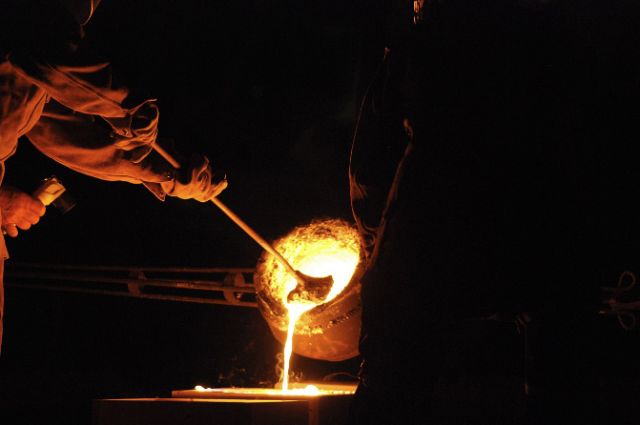Metal has a long history, with humans using metal tools and weapons to boost society and increase protection. Metal casting techniques are thousands of years old, though they’re still essential to modern society. Foundry services provide several benefits to companies needing precision parts for their designs.
Exploring the processes behind casting parts can help you better understand how to help clients. You can implement the casting process steps to boost efficiency and ensure high-quality parts for clients and customers.
The more metalworking expertise you have, the more likely your casting company is to find sustainable success. It’s an essential step for your manufacturing solutions. Continue reading to learn more about casting techniques and the industries they can help today!
What Is Metal Casting?
Metal casting has a history dating back thousands of years. It can be used in manufacturing or fine art production.
The process involves heating metal until it becomes molten. Upon reaching this state, the metal is poured into a mold to create a positive cast item or part.
The metal is given time to cool until it can be removed from the mold. Traditional methods used for metal casting include:
- Lost-wax casting
- Plaster mold casting
- Sand casting
- Die casting
You can use the above casting methods to produce jewelry or for use with foundry services. Other ways you can use these forms of metal casting include creating sculptures, weapons, transportation, and tools.
What Is Metal Casting Used for Today?
Historically, Metal casting techniques were used for weapons, tools, and religious objects. Though the purpose of the techniques has changed, they still play a vital role in helping modern society.
It is an excellent way to save money while creating complex shapes and designs using metal. The sizes range from a few grams of metal to thousands of pounds.
Most castings are used to create heavy machinery and transportation. Other industries where you’ll find metal cast parts are:
- Household appliances
- Construction equipment
- Farming equipment
- Electrical components
- Defense
- Tools
- Automobile parts
- Aerospace parts
- Machining tools
Exploring the different techniques can help your brand learn to create these components and gain new clients. It’s a vital step toward reaching sustainability.
Types of Metal Casting
Now that you have an enhanced understanding of the uses of metal casting parts, it’s worth exploring the techniques and steps of the casting process. You can leverage these techniques to expand product lines and help clients receive the needed parts.
Expendable Mold Casting
Expendable mold casting using single-use casts and temporary molds to create the necessary parts for client orders. The common ingredients in the molds are ceramic shells, resin-bonded sand, and plaster or foam investments.
You can make expendable mold casts at your company to save money. It is also a way to save your company time when creating custom parts. Consider this method if you’re using small-volume production.
Non-Expendable Casting Mold
Non-expendable casting molds are a reusable option that provides more permanence when casting metal parts. These molds are often more robust and can withstand higher temperatures.
Most permanent molds are made from steel and other metals, such as cast iron. These metals offer impressive strength, resistance to heat, and high porosity.
If you plan on creating several of the same parts, it is best to use a non-expendable casting mold. They are durable and can help you meet the client’s order with minimal difficulties.
What Is the Metal Casting Process?
The metal casting process requires several steps to produce quality parts for your clients. It starts with creating a pattern and mold. The molten metal is poured into the mold to make the ordered parts.
Take a look at each of the casting process steps to gain an in-depth understanding. It is the first step toward expanding your foundry services and becoming the top American casting company.
- Create the Pattern
The first step is to create the pattern for the part you wish to make using molten metal. The pattern determines the mold’s shape and helps you create precision parts.
The best option is to create a three-dimensional model of your final cast to understand what the finished parts will look like. Your choices include wax, plastic, wood, or sand.
Plaster and silicone are viable options if you plan on using expendable casting molds. You can create wax multiples in mass to create several metal parts while saving time and money.
When creating the pattern for your mold, it’s vital to account for shrinkage. Sprues are another option for allowing the molten metal to flow into the mold.
- Create the Mold
After creating the pattern, the next step is to make the mold. To create metal parts for your manufacturing solutions, you can choose a reusable mold or an expendable option.
When creating a reusable mold, it’s best to use metal. Each method for making molds has advantages and drawbacks. You can create molds with varying levels of complexity, depending on the purpose of the metal parts.
- Choose Your Alloy
When you’ve finished creating your mold, you’ll want to begin considering the different alloy options for your casting parts. The top two options are ferrous and non-ferrous alloys.
Alloys are a combination of elements that provide mechanical properties beneficial for the intended use of the metal parts. Ferrous options include steel, gray iron, and malleable iron. Common non-ferrous alloys used in metal casting are copper, bronze, and aluminum.
Precious metals can also be used in metal casting techniques. Copper, gold, platinum, and silver are the best precious metals for these processes.
- Melt the Alloy
Melting the alloy can lead to the next step, casting metal parts for your next client’s contract. The melting processes will vary depending on the alloys you’re attempting to use.
Each alloy has a specific melting temperature. To melt your chosen alloy, place it in a crucible and heated over a furnace or open flame until it becomes molten. After the alloy you’ve chosen reaches its melting point, you can move toward pouring the mold.
- Pour the Molten Alloy Into the Mold
When you pour the molten alloy into the chosen mold, you’ll be closer to a finished metal part. If you’re handling a small-scale process, pour the molten alloy from the crucible into the mold.
If you’re heating a large amount of metal and then attempting to pour it, it’s best to work with a team. The team will heat the metal over the furnace before transferring it into the mold your team has created.
When pouring the molten metal into the mold, follow all OSHA safety guidelines for worker safety. All team members should wear protective equipment and clothing. Long pants and sleeves and natural fiber clothing are must-haves for this process.
A well-ventilated space is also recommended to enhance worker safety. Increasing ventilation in the workspace can reduce the risk of toxic fumes.
Most of all, keep a chemical fire extinguisher nearby to stop fires before they can spread. It’s best to allow the mold to solidify before proceeding.
- Remove the Casting
You can remove the casting parts from the mold when both have cooled off. Check the metal to ensure it has cooled and solidified sufficiently.
If you opt for an expendable mold, you can proceed to break the mold away from the casting. Plaster investments require water to remove the mold from the casting. The water will help to break the plaster away from the metal and allow you to access the finished metal part.
Ejector pins are the best option for working with a reusable mold. It’s the safest way to access the finished parts without risking unnecessary damage.
- Finish the Metal Part
The last step you’ll use in the casting process is to finish the metal part you’ve created. The process involves filing and polishing the metal to help it achieve the best final appearance.
You’ll want to clean the metal and scrub away any residue or excess mold on its surface. Upon breaking the metal away from the mold, you’ll have an impressive finished part that will please your client.
What Tools Are Required?
If you want to learn how to begin casting parts, you’ll need the proper tools. The top tools to invest in for your at-home foundry are safety equipment, metal tongs, a crucible, a mold, and a furnace, torch, or kiln.
With these tools, you can begin creating jewelry and custom metal parts. It’s the ultimate way to gain metalworking expertise.
Begin Casting Parts for Clients Today
Learning the metalworking basics can put you on the fast track toward casting parts and meeting client orders. The top two process options are expendable and non-expendable molds.
You’ll also need to choose the alloy you want for your project to achieve the best results. Melt the metal and pour it into the mold before it cools to get your clients’ metal parts.
Enhancing your business’s capabilities is essential to staying at the top of your industry. Read more of our Business blog content for tips on propelling your company and its services forward!







